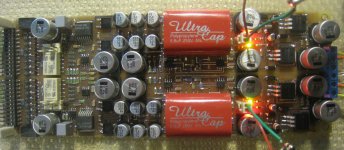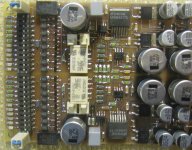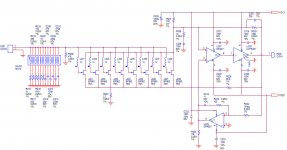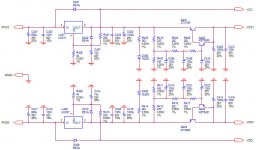Is completed. 0.3nV/rtHz noise, under 50ppm distortions, the same +/-0.1dB RIAA.
An extremely simple signal chain (uses feedback, though) with active RIAA correction, thanks to a noise cancelling power supply buffer, using a Sziklay configuration for the series device "regulators".
Uses only BF862 devices, no caps in the signal path (except the big red polyprop output caps), selectable gain (48dB MM, 60dB MC). and the same switchable input impedance network.
The same performance as HPS 3.1, HPS 4.1 and HPS 4.2 at 50% complexity, price, size.
Fully SMD construction, thin film NiCr resistors, only C0G ceramics in the signal path.
Attached, the full construction and the new headamp and noise cancelling power supply buffer details.
Currently doing the precise measurements. Soon to be available (schematics, Gerbers, measurements) on my web site.
BTW, I have posted on my web site the HPS 4.2 (new bipolar version with shunt local power supply regulators).
An extremely simple signal chain (uses feedback, though) with active RIAA correction, thanks to a noise cancelling power supply buffer, using a Sziklay configuration for the series device "regulators".
Uses only BF862 devices, no caps in the signal path (except the big red polyprop output caps), selectable gain (48dB MM, 60dB MC). and the same switchable input impedance network.
The same performance as HPS 3.1, HPS 4.1 and HPS 4.2 at 50% complexity, price, size.
Fully SMD construction, thin film NiCr resistors, only C0G ceramics in the signal path.
Attached, the full construction and the new headamp and noise cancelling power supply buffer details.
Currently doing the precise measurements. Soon to be available (schematics, Gerbers, measurements) on my web site.
BTW, I have posted on my web site the HPS 4.2 (new bipolar version with shunt local power supply regulators).
Attachments
My eyes hurt just THINKING about putting that many eentsy SMDs on a board.
Looking forward to seeing the schematics.
Looking forward to seeing the schematics.
Schematics
100% hand soldered. It's actually my first large SMD project and it went smoother than I was expecting. Work and rework is a breeze, in particular if a fine point soldering iron and very fine, no flux residue, solder is used. My eyes can't handle anything under 1206, though.
Attached the simplified (without gain switching) x40 head amp schematic (the active RIAA stages are identical in all HPS preamps) and the low noise power supply.
Regarding the Sziklay power buffer, the output noise is cut in half since Q401/Q404 noise contribution is cancelled by the negative feedback from transistor Q402/Q403. This is a major improvement over using a darlington. For noise reasons, using power MOSFETs are here excluded. The ZTX690/ZTX790 pair is low noise (Rbb~10ohm). Reference: http://pstca.com/spice/ripple/ripple.htm#cancl
100% hand soldered. It's actually my first large SMD project and it went smoother than I was expecting. Work and rework is a breeze, in particular if a fine point soldering iron and very fine, no flux residue, solder is used. My eyes can't handle anything under 1206, though.
Attached the simplified (without gain switching) x40 head amp schematic (the active RIAA stages are identical in all HPS preamps) and the low noise power supply.
Regarding the Sziklay power buffer, the output noise is cut in half since Q401/Q404 noise contribution is cancelled by the negative feedback from transistor Q402/Q403. This is a major improvement over using a darlington. For noise reasons, using power MOSFETs are here excluded. The ZTX690/ZTX790 pair is low noise (Rbb~10ohm). Reference: http://pstca.com/spice/ripple/ripple.htm#cancl
Attachments
Once again, a gorgeous beast!
I am surprised that the simple common source input stage outperforms its complex ancestors in versions 3 and 4 thd-wise.
Rüdiger
I am surprised that the simple common source input stage outperforms its complex ancestors in versions 3 and 4 thd-wise.
Rüdiger
I am surprised that the simple common source input stage outperforms its complex ancestors in versions 3 and 4 thd-wise.
While the noise and distortion performance are about the same (or slightly better, due to the excellent transconductance, noise and Ciss of the BF862 devices), HPS5.0 doesn't have the superb common mode rejection of the symmetrical HPS3.x and HPS4.x. Hence, HPS 5.0 requires more careful shielding, in particular against the 60Hz (and harmonics) hum. But OTOH it uses only stock components, in current production, it's smaller and cheaper to build.
or slightly better, due to the excellent transconductance, noise and Ciss of the BF862 devices)
Ciss is almost an order of magnitude better than my then favorite 2sk369 (10pf vs. 75pf) so it's an excellent choice!
Rüdiger
Hi Ovidiu,
again a nice surprise from you! Thanks a lot, just when I was already thinking about a monster phono stage 😉 And SMD is fun anyway. Maybe the time has come for me to try an opamp monster.
All the best, Hannes
PS: just curious - what are the dimensions of the board?
Working with 0805 here...
again a nice surprise from you! Thanks a lot, just when I was already thinking about a monster phono stage 😉 And SMD is fun anyway. Maybe the time has come for me to try an opamp monster.
All the best, Hannes
PS: just curious - what are the dimensions of the board?
My eyes can't handle anything under 1206, though.
Working with 0805 here...
Last edited:
just curious - what are the dimensions of the board?
7.5 x 20 cm. HPS 3.1 is 10 x 23 cm and HPS 4.1 is 10 x 26 cm.
- Status
- Not open for further replies.
- Home
- Source & Line
- Analogue Source
- Hps 5.0



